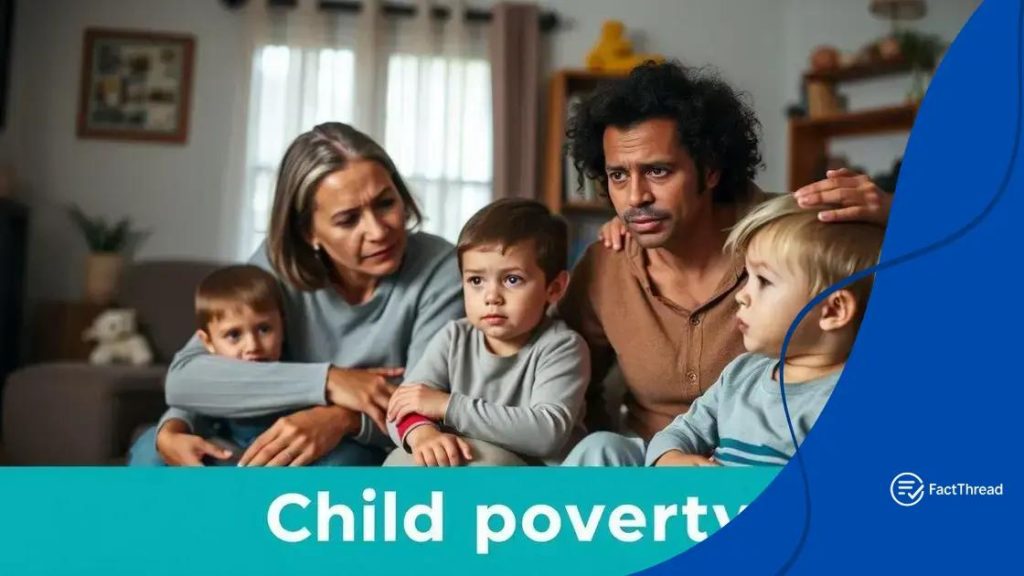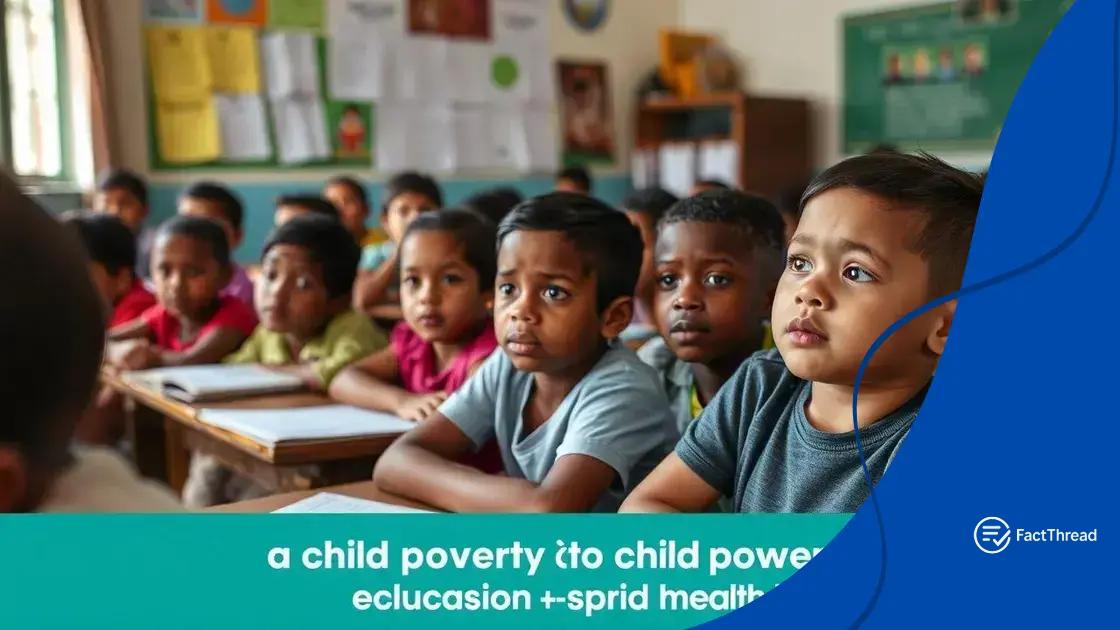Slight increase in child poverty rates affects families

A slight increase in child poverty rates has significant effects on education and health, requiring community initiatives and government policies to provide necessary support for affected families.
A slight increase in child poverty rates has sparked discussions about the well-being of our youngest citizens. As families face new challenges, it’s important to explore what this means for our communities and future generations.
Understanding the current child poverty trends
Understanding the current child poverty trends is essential to addressing the issues facing countless families today. Recent reports indicate that there is a sight increase in child poverty rates, which can significantly impact children’s futures. To effectively combat these trends, we must first examine what contributes to them.
Factors Affecting Child Poverty
Several factors can lead to these rising rates. Economic changes, such as job losses and decreasing wages, play a crucial role. Additionally, the ongoing impact of the pandemic has left many families struggling.
- Job insecurity leading to unstable household income
- Rising costs of living, including housing and food
- Lack of access to quality education and resources
- Health crises affecting income and stability
Another important aspect to consider is the social safety net. Programs designed to support families often face budget cuts, which can exacerbate the challenges they face.
The Role of Education
Education is a vital factor in breaking the cycle of poverty. Children from disadvantaged backgrounds may not have the same opportunities as their peers. It’s vital to invest in educational programs that provide support and resources to these children.
- After-school programs offering tutoring
- Access to technology and the internet
- Scholarships and financial aid for low-income families
Communities can also make a difference by organizing initiatives aimed at helping those in need. Collaboration between schools, local groups, and government can help raise awareness and address the root causes effectively.
Factors contributing to the rise in child poverty
Various factors contribute to the rise in child poverty, each intertwined in complex ways. It helps to recognize how these factors influence families and communities.
Economic Challenges
One of the most significant influences is economic hardship. Job loss affects families drastically. When parents are unemployed or underemployed, it leads to a decrease in household income. This reduction makes it difficult to provide basic needs such as food, clothing, and shelter.
- Increased cost of living
- Rising child care expenses
- Limited job opportunities in certain regions
Moreover, economic instability can create a ripple effect. Families may struggle to pay rent, leading to evictions and unstable living situations.
Social and Educational Barriers
In addition to economic issues, there are social factors at play. A lack of access to quality education can perpetuate poverty. Children who do not have the same educational resources are at a disadvantage. They may not have access to extracurricular programs that promote personal growth.
- Underfunded schools in low-income areas
- Insufficient access to tutoring and mentorship programs
- High dropout rates among low-income students
Furthermore, health problems can impact family income and child development. Families dealing with illness may face extra expenses, further straining their budget. This cycle can make it challenging to break free from poverty.
Additionally, policies that fail to support low-income families contribute to the problem. Cutting essential funding and services can worsen the situation. Therefore, understanding these factors is vital for creating effective solutions.
Impact of child poverty on education and health

The impact of child poverty on education and health is profound and far-reaching. Children living in poverty face obstacles that can hinder their development in critical areas, making it essential to address these issues.
Effects on Education
Children from low-income families may struggle to succeed in school. Poor access to educational resources can affect their learning outcomes. When families cannot afford basic school supplies, it puts students at a disadvantage compared to their peers.
- Higher rates of absenteeism due to unstable housing
- Limited access to after-school programs and tutoring
- Reduced opportunities for extracurricular activities
Additionally, schools in low-income areas often receive less funding, leading to fewer teachers, larger class sizes, and outdated materials. This lack of resources can diminish the quality of education these children receive.
Health Implications
The health implications of child poverty are equally concerning. Children in these situations face higher risks for a range of health issues, including malnutrition and chronic illnesses. When families struggle to make ends meet, it affects their ability to access nutritious food and adequate healthcare.
- Increased exposure to environmental hazards
- Higher likelihood of mental health issues
- Limited access to regular health check-ups
Moreover, the stress that comes with financial instability can take a toll on children’s mental well-being. It can lead to anxiety and depression, further complicating their educational challenges. Ensuring that children have the support they need in both education and health is vital for their success.
Community initiatives to combat child poverty
Community initiatives play a crucial role in combating child poverty. These local efforts can provide the resources and support that families need to improve their circumstances.
Supportive Programs
Many communities have implemented programs designed to directly assist low-income families. These include food banks, after-school programs, and job training workshops. By addressing basic needs, these initiatives can significantly impact families dealing with financial hardships.
- Food distribution programs to ensure children receive nutritious meals.
- Educational support to help children succeed in school.
- Job training opportunities for parents to improve employability.
For example, after-school programs not only provide supervision, but they also offer homework help and enrichment activities. This support allows children to develop skills while giving parents peace of mind.
Collaboration and Community Engagement
Collaboration among local organizations is essential for maximizing impact. Community leaders, schools, and nonprofits can partner to create comprehensive support systems. When resources are pooled, communities can better tackle the systemic issues that lead to poverty.
- Joint events to raise awareness and funds for poverty reduction.
- Shared resources like community centers for workshops and education.
- Local outreach programs to inform families about available services.
Furthermore, engaging community members fosters a collective responsibility towards alleviating child poverty. Initiatives that involve volunteers not only provide assistance but also help create a sense of community. When everyone works together, the chances of success increase.
Government policies addressing child poverty
Government policies play a vital role in addressing child poverty. These policies aim to create safety nets for families and improve their living conditions.
Assistive Programs
One of the key aspects of these policies includes assistance programs such as food stamps and Medicaid. These programs help families afford basic necessities like food and healthcare.
- Food assistance programs provide support for nutritious meals.
- Healthcare coverage ensures children receive medical attention.
- Childcare subsidies help working parents afford quality care.
These support systems are crucial for alleviating the daily burdens that families face, allowing them to focus on long-term stability.
Education Initiatives
Education is another critical area where government policies make an impact. Programs that fund low-income schools help provide resources for students who need them the most. Quality education can be a powerful tool for breaking the cycle of poverty.
- Funding for books and learning materials
- Scholarships for further education
- Tutoring and mentorship programs
By improving educational opportunities, governments can help children achieve better outcomes. Investing in education is essential for fostering a brighter future for all children.
Legislation for Families
Legislation that addresses the root causes of poverty is also vital. Policies that raise the minimum wage or provide tax credits for low-income families can uplift many households. This boosts their overall economic stability.
Moreover, effective child protection laws help families navigate challenges. Ensuring access to social services and legal support can provide families with the guidance they need.
Government policies must continually evolve to meet the needs of families effectively. By addressing child poverty through targeted initiatives, communities can foster an environment where all children can thrive.
\n
FAQ – Frequently Asked Questions about Child Poverty
What are the main causes of child poverty?
Child poverty can result from economic instability, lack of access to education, and limited job opportunities for parents.
How does child poverty affect education?
Children living in poverty often have fewer resources, leading to higher absenteeism and lower academic performance.
What programs can help reduce child poverty?
Support programs like food assistance, education funding, and job training initiatives can help families escape poverty.
What can individuals do to help combat child poverty?
Individuals can volunteer, donate, or advocate for policies that support low-income families and improve educational opportunities.